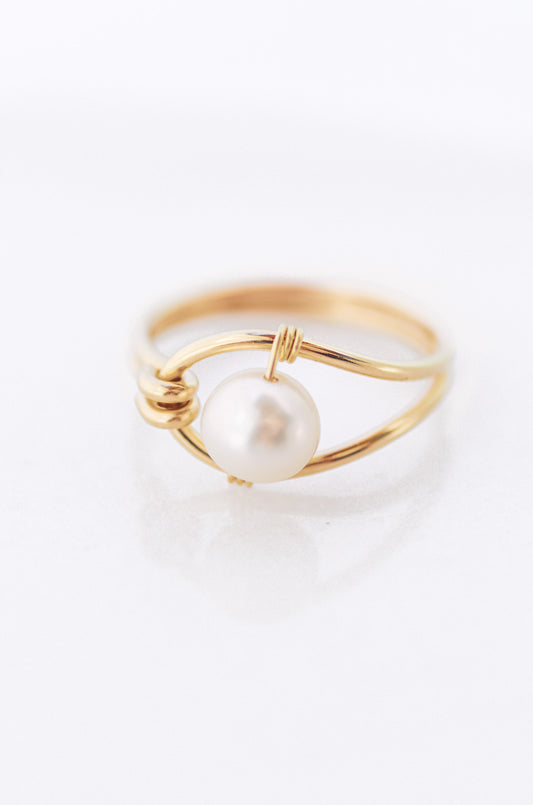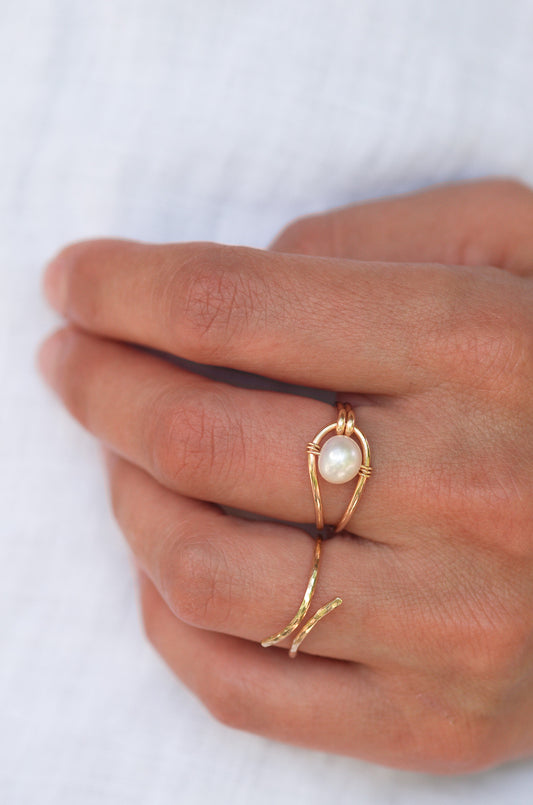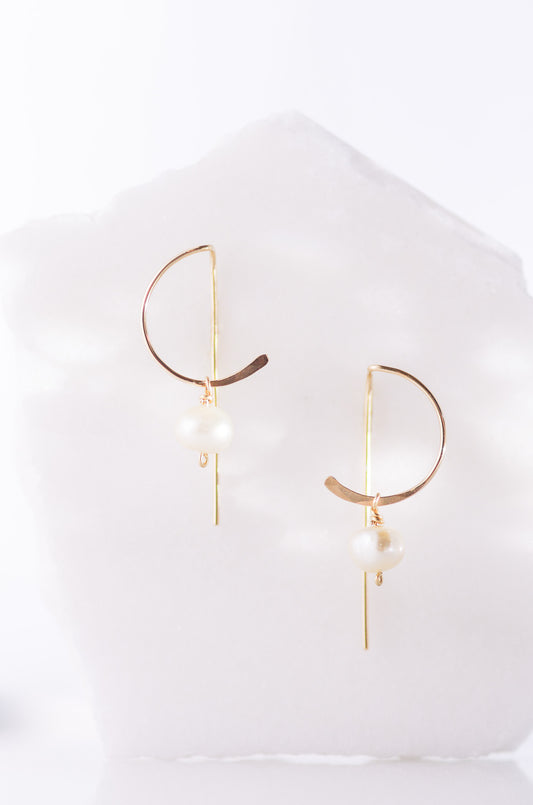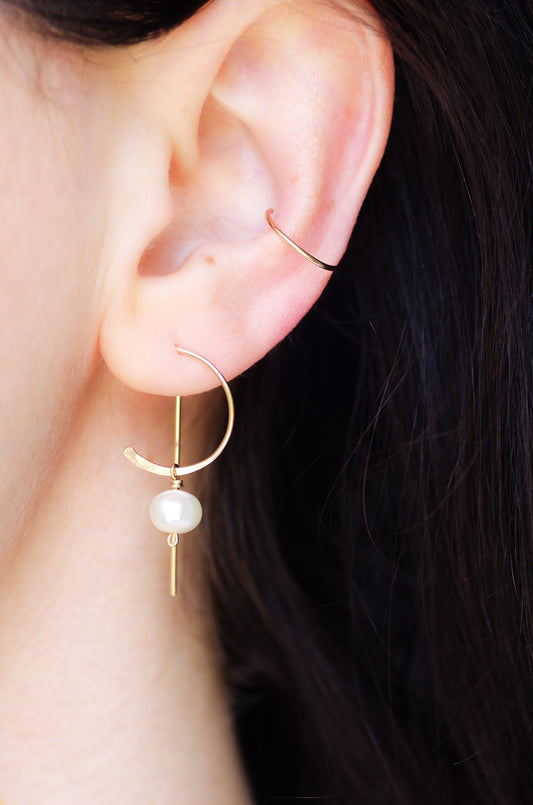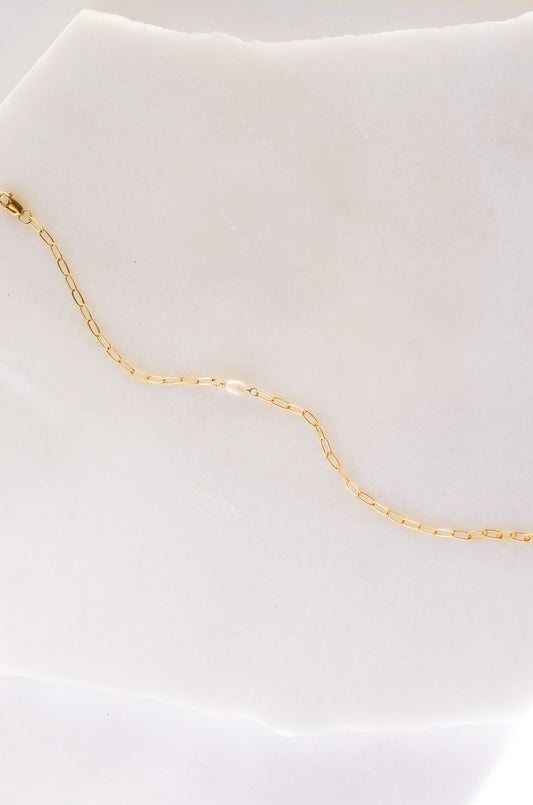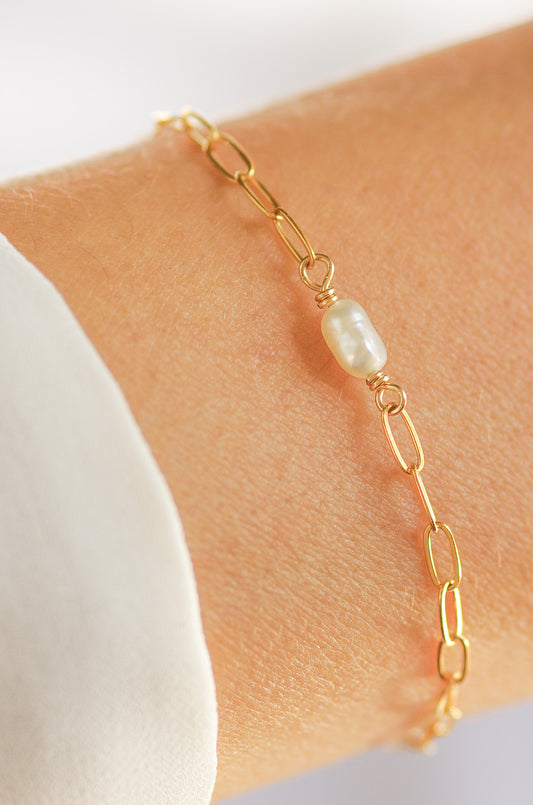How Gold-Fill Differs from Gold-Plated
Condividere
Gold-fill and gold-plated jewellery may look similar, but they are vastly different in quality, durability, and how they affect your skin and the planet. Here's the quick breakdown:
- Gold-fill uses a thick layer of real gold (≥5% of the piece's weight) bonded to a base metal. It’s long-lasting, tarnish-resistant, and better for sensitive skin. The process avoids chemicals, making it a cleaner choice. Prices typically range from €40 to €400+.
- Gold-plated involves a very thin gold layer applied via electroplating. It’s cheaper (€5–€50), but the coating wears off quickly, exposing base metals that may irritate skin. The process also involves chemicals and generates more waste.
Quick Comparison
| Feature | Gold-Fill Jewellery | Gold-Plated Jewellery |
|---|---|---|
| Gold Content | Thick layer (≥5% by weight) | Thin layer (<0.05%) |
| Durability | Long-lasting, resists wear | Wears down quickly |
| Skin Safety | Hypoallergenic | May cause irritation |
| Eco Impact | Cleaner process, less waste | Chemical-heavy process |
| Price Range (€) | €40–€500+ | €5–€50 |
If you want jewellery that lasts and aligns with eco-conscious values, gold-fill is the better choice. For trendy, short-term pieces, gold-plated may work, but expect less durability.
1. Gold-Fill Jewellery
Gold-fill jewellery offers a blend of durability and elegance, all at a more affordable price point. Let’s take a closer look at its composition, longevity, eco-conscious benefits, and skin-friendly attributes.
Material Composition
Gold-fill jewellery is made by bonding a thick layer of solid gold, usually 14K, to a base metal using heat and pressure. This gold layer must account for at least 5% of the piece’s total weight - making it about 100 times thicker than gold-plated jewellery[3][4]. This difference in gold content sets it apart from plated alternatives, both in quality and durability.
The base metal is often brass, chosen for its compatibility with the bonding process. Brands like Rays & Riches take it a step further by using ethically sourced and recycled metals, reducing their environmental impact. The bonding process itself is chemical-free, ensuring a strong, lasting connection between the gold and the base metal that won’t separate over time.
Durability
The thicker gold layer in gold-fill jewellery ensures it’s built to last. It resists tarnishing, peeling, and chipping, making it ideal for everyday wear[2][5]. Unlike thinner coatings, gold-fill retains its appearance over time without exposing the base metal underneath, even with frequent use.
Caring for gold-fill jewellery is straightforward. Any loss of shine is typically due to dirt buildup, which can be easily cleaned with a damp cloth[2]. Its durability also eliminates the need for re-plating, making it a smart, long-term choice for jewellery enthusiasts.
Environmental Impact
Gold-fill jewellery stands out as a more eco-friendly option due to its chemical-free manufacturing process, which reduces industrial waste[3]. This aligns with the growing demand for sustainable choices in the jewellery market.
Rays & Riches exemplifies this eco-conscious approach by incorporating recycled vintage pearls and gemstones into their designs, avoiding the environmental toll of mining new materials. Additionally, their use of recycled metals further lowers their ecological footprint, all while maintaining the high-quality standards their customers value.
Skin Sensitivity
For those with sensitive skin or metal allergies, gold-fill jewellery is an excellent choice. The thick gold layer creates a protective barrier that prevents the base metal from coming into contact with the skin[1][2]. This significantly reduces the risk of irritation or allergic reactions often associated with other types of jewellery.
The chemical-free bonding process also contributes to its skin-friendly nature by eliminating potential irritants. This makes gold-fill jewellery particularly suitable for items like earrings and rings, which often remain in close contact with the skin for extended periods.
2. Gold-Plated Jewellery
Gold-plated jewellery offers a budget-friendly way to enjoy the look of gold, but it stands apart from gold-filled pieces in terms of both composition and longevity. Knowing how it's made and its limitations can help you make better choices when shopping for jewellery.
Material Composition
Gold-plated jewellery is crafted by applying a thin layer of gold onto a base metal through a method called electroplating. This process involves using an electric current to bond the gold to the underlying metal. Common base metals include copper, brass, nickel, and silver. A specific type of gold-plated jewellery, known as vermeil, uses silver as the base metal [6][7][8].
"Electroplating is the process of coating one metal or metal object with a very thin layer of another metal, typically by applying a direct electric current. This partially dissolves the metals and creates a chemical bond between them." – Sharretts Plating Company [6]
The thickness of the gold layer can vary significantly. Pieces labeled as "gold flashed" or "gold washed" have less than 0.5 microns of gold, while standard gold-plated items feature a coating of 0.5 microns or more [7]. At the higher end, heavy gold-plated or vermeil jewellery has a gold layer of at least 2.5 microns [7]. For reference, the typical electroplating layer is about 0.0002 inches thick [6], which is much thinner than the gold layer found in gold-filled jewellery.
To enhance durability and reduce tarnishing, intermediate layers of metals like copper or nickel are often used between the base metal and the gold layer [6][7].
Durability
The thin gold coating on gold-plated jewellery makes it more susceptible to wear and tear. Over time, regular use can erode the gold layer, eventually revealing the base metal underneath. When this happens, the jewellery's appearance can change noticeably, so handling it with care and maintaining it properly is crucial.
Environmental Impact
The electroplating process requires immersing the jewellery in a chemical solution containing metal salts, followed by the application of an electric current [6]. This reliance on chemical treatments raises environmental concerns for some buyers who prioritize eco-friendly practices.
Skin Sensitivity
As the gold layer wears away, the base metals - especially nickel - can come into direct contact with your skin [6][7]. Since nickel is a common allergen, gold-plated jewellery may not be the best choice for those with sensitive skin or metal allergies.
Understanding these characteristics provides a clearer picture of both the benefits and drawbacks of gold-plated jewellery, helping you decide if it’s the right fit for your needs.
sbb-itb-2024ddf
Advantages and Disadvantages
Building on the characteristics we discussed earlier, this section highlights the main pros and cons of gold-fill and gold-plated jewellery. Understanding these differences can help you weigh their value in terms of durability, cost, environmental impact, and skin safety.
Material Quality and Value
When it comes to material quality, gold-fill jewellery stands out. With a thick layer of gold (at least 5% of its weight), it offers a long-lasting finish that justifies its higher price tag.
That said, this quality comes with a higher upfront cost. Gold-fill pieces usually range between €40 and €200 or more, making them a bigger investment. On the other hand, gold-plated jewellery is much more budget-friendly, starting at around €10 to €50. If you're looking for trendy pieces for occasional wear, this lower price point can be very appealing.
Durability and Longevity
The durability difference between these two options is hard to ignore. Gold-fill jewellery is built to last, even with daily use. Its thick gold layer resists tarnishing, peeling, and fading. In contrast, gold-plated jewellery, with its thin electroplated layer, wears down much faster - especially on items like rings and bracelets that are exposed to frequent contact.
Environmental and Ethical Considerations
Gold-fill jewellery has a smaller environmental footprint. Its bonding process is chemical-free, and many brands use recycled materials to create their pieces. For example, Rays & Riches takes sustainability a step further by incorporating ethically sourced metals, recycled materials, and even vintage pearls and gemstones. This approach reduces the need for new mining.
Gold-plated jewellery, on the other hand, relies on chemical-intensive electroplating processes. Additionally, the shorter lifespan of these pieces often leads to more waste and resource consumption over time, as they’re replaced more frequently.
Health and Skin Compatibility
If you have sensitive skin, gold-fill jewellery is a safer choice. Its thick gold layer acts as a barrier, reducing the risk of allergic reactions to the base metals underneath. With gold-plated jewellery, however, the thin gold coating can wear away, potentially exposing allergenic metals like nickel or brass.
Here’s a quick comparison to summarise these points:
| Feature | Gold-Fill Jewellery | Gold-Plated Jewellery |
|---|---|---|
| Material Quality | Thick gold layer (≥5% by weight), heat/pressure bonded | Thin gold layer (<0.05%), electroplated |
| Durability | Long-lasting; resists tarnish, chipping, peeling | Fades, tarnishes, and peels quickly |
| Environmental Impact | Uses recycled materials; chemical-free bonding | Chemical-intensive process; more waste |
| Skin Sensitivity | Hypoallergenic; safe for sensitive skin | May irritate skin as coating wears off |
| Price Range (€) | €40–€200+ | €10–€50 |
| Maintenance | Minimal - requires occasional cleaning | Needs careful handling and re-plating |
Practical Decision Factors
When deciding between the two, it comes down to how you plan to use the jewellery. Gold-fill is perfect for daily wear and timeless styles. It holds up well over time and requires minimal upkeep. On the flip side, gold-plated jewellery is better for experimenting with bold, trendy designs. Its lower cost makes it easier to explore new styles, but keep in mind that its durability is limited and it may need more frequent replacement or maintenance.
Conclusion
The enduring appeal of gold-fill jewellery becomes evident when you consider its key advantages. With a thicker layer of gold, these pieces offer a higher gold content, ensuring durability and lasting elegance. While gold-fill jewellery may have a higher upfront cost, it proves to be a worthwhile investment, maintaining its appearance and integrity far longer than gold-plated alternatives, which often need frequent replacement or re-plating.
Beyond its longevity, gold-fill jewellery is also gentle on the skin, thanks to its protective gold layer, and it stands out for its environmentally conscious production methods, avoiding harsh chemicals. Brands like Rays & Riches lead by example, using ethically sourced metals and repurposing vintage materials to create stunning, sustainable designs.
In Italy, where craftsmanship and quality are deeply valued, gold-fill jewellery resonates with those who appreciate its durability, ethical origins, and timeless beauty. Whether you're curating a capsule jewellery collection or searching for everyday pieces, gold-fill offers the perfect combination of resilience, responsibility, and refined style.
Opt for gold-fill jewellery to enjoy enduring elegance while supporting ethical and sustainable practices.
FAQs
Why is gold-fill jewellery better than gold-plated for everyday wear?
Gold-fill jewellery stands out as an excellent option for everyday use thanks to its durability and skin-friendly nature. Unlike gold-plated pieces, gold-fill jewellery contains significantly more gold - about 100 times more - making it far less prone to tarnishing or wear. This means your jewellery will maintain its charm and shine, even with frequent use.
What’s more, the gold-fill process relies on heat and pressure rather than chemicals, making it gentler on sensitive skin. It’s also a more environmentally conscious choice, as it avoids the harmful effects associated with chemical bonding methods. With gold-fill jewellery, you’re choosing a long-lasting, skin-safe, and eco-conscious accessory that’s perfect for everyday wear.
What makes gold-fill jewellery more sustainable than gold-plated jewellery?
Gold-fill jewellery stands out as a more eco-friendly option because its production relies on heat and pressure rather than harmful chemicals. This avoids the use of substances like cyanide, which are commonly associated with gold-plating, making it a safer choice for the environment and for individuals with sensitive skin.
What’s more, gold-fill contains 100 times more gold than gold-plated jewellery. This not only gives it a much longer lifespan but also cuts down on the need for frequent replacements. By incorporating recycled metals and repurposed materials such as vintage pearls and gemstones, gold-fill further reduces the environmental strain caused by mining and sourcing new materials.
Is gold-fill jewellery safe for people with sensitive skin or metal allergies?
Gold-fill jewelry is an excellent choice for anyone with sensitive skin or metal allergies. It features a thick layer of real gold bonded to a base metal, which helps minimize contact with materials that might irritate the skin. Plus, gold-fill is completely free of lead and nickel, making it hypoallergenic and kind to your skin. The bonding process doesn't involve any harsh chemicals, offering a safer and more skin-friendly option for daily use.

